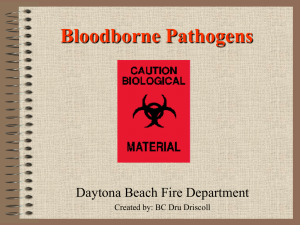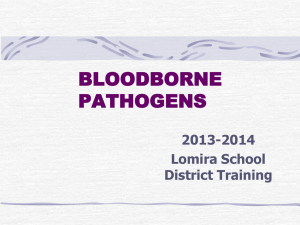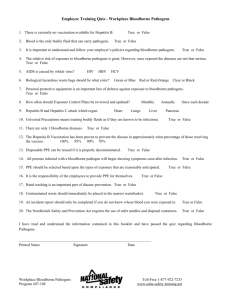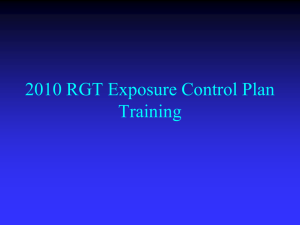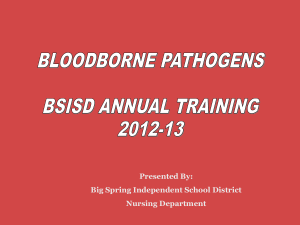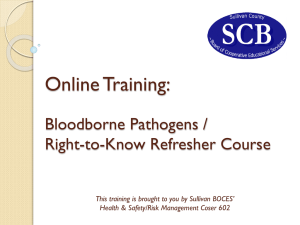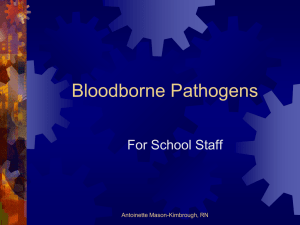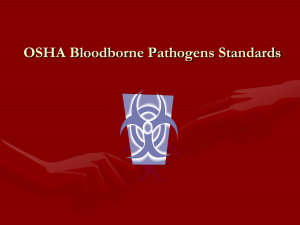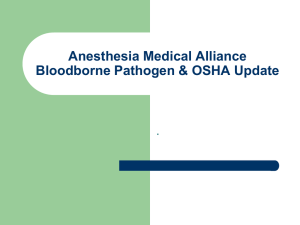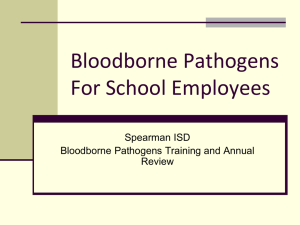Bloodborne Pathogen Training for Madison
advertisement
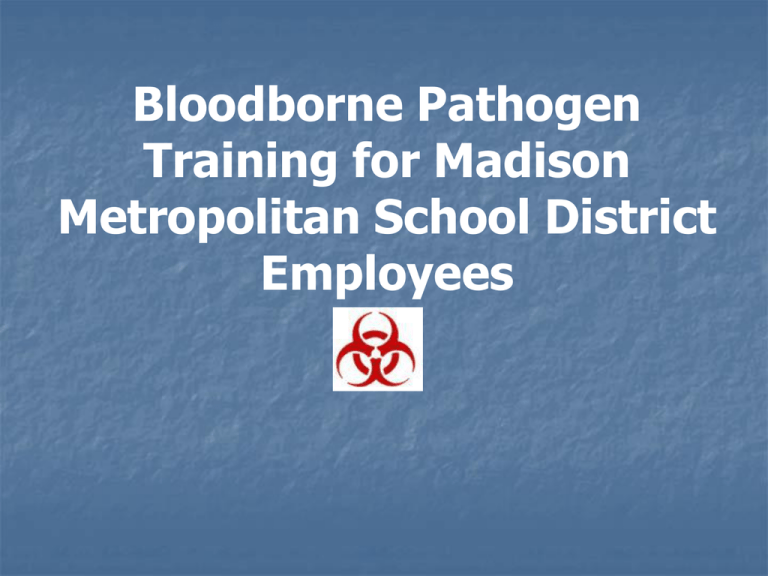
Bloodborne Pathogen Training for Madison Metropolitan School District Employees Bloodborne Pathogens Bloodborne pathogens are microorganisms found in human blood that can cause disease in humans. These pathogens include, but are not limited to; • Hepatitis B virus (HBV) • Hepatitis C virus (HCV) • Human Immunodeficiency Virus (HIV) Hepatitis B Virus (HBV) Cause of Hepatitis B, a serious liver disease Symptoms include jaundice (yellow eyes and skin), fatigue, nausea Once infected, a person can remain a carrier for life Half of all carriers have no symptoms at all Can result in liver failure and death 5000 deaths in U.S. annually No cure There is a vaccine Hepatitis C Virus (HCV) Causes Hepatitis C disease Similar symptoms to Hepatitis B Carriers may have no symptoms 3 million people in the U.S. are chronically infected with HCV Leading indicator for liver transplantation in the U.S. 10,000 die annually from HCV No vaccine Human Immunodeficiency Virus (HIV) Virus that causes Acquired Immune Deficiency Syndrome (AIDS) Attacks and breaks down the body’s immune system As of August 2006, 1.15 million infected in the U.S. Treatable, but not curable, with antiviral drugs No vaccine Bloodborne Pathogens can be contracted: • when open skin or mucous membranes (eyes, nose, mouth) come in contact with blood or other body fluids such as: • • • • Or by puncturing the skin with sharp objects that are contaminated with these fluids • • • • • Semen Vaginal secretions Any body tissue or fluid that contains visible blood Needles Glass Scalpels Knives School employees may be at risk of exposure to bloodborne pathogens as a result of caring for children or adults, or through their daily work OSHA Standards • The Madison Metropolitan School District has developed an Exposure Control Plan in accordance with the Occupational Safety & Health Administration of the U.S. Department of Labor (OSHA). • The Exposure Control Plan is designed to eliminate or minimize the risk to employees from exposure to Bloodborne Pathogens Exposure Control Plan 1. 2. 3. 4. 5. 6. 7. Hepatitis B vaccination Standard Precautions Personal Protective Equipment Handwashing Housekeeping Disposal of waste What to do if you are exposed 1. Hepatitis B Vaccination A three-shot vaccination series Offered by MMSD free of charge for employees in job classifications that are likely to be exposed: Nurses Nurse’s assistants Custodians School Security Assistants Special Education Assistants 2. Standard Precautions All human blood and certain human body fluids and non-intact skin should be treated as if known to be infectious for HIV, HBV and other bloodborne pathogens Cover all hand cuts and abrasions with a bandaid prior to contact with others Do not eat, smoke, apply cosmetics or lip balm when or where it is likely that blood or body fluid contact may occur 3. Personal Protective Equipment (PPE) A barrier between the employee and the potentially infectious material Available from the school district at no cost to the employee Examples of PPE Gloves Masks Aprons Gowns CPR masks Mouthpieces Protective eyewear Face shields Lab coats 3. Personal Protective Equipment (PPE) Gloves Gloves are the most common PPE used in schools Gloves must be worn whenever contact with potentially infectious material is possible, including when cleaning body fluid spills If gloves are penetrated, torn or contaminated, remove immediately and dispose of without touching the outside of the glove Hypoallergenic gloves are available to employees 4. Handwashing The single most effective way to prevent infections Hands must be washed after contact with blood, body fluids, excretions or secretions Hands must be washed immediately after removing gloves Use liquid soap and running water and a clean paper towel for drying If using alcohol-based hand sanitizer, wash with soap and water as soon as possible 5. Housekeeping Controls Clean and disinfect surfaces that have been in contact with potentially infectious materials as soon as possible Use a broom and dustpan, never your hands, to pick up broken glass or other contaminated sharp objects Contact a custodian, school nurse or nurse’s assistant for proper decontamination of body fluid spills 6. Disposal of Waste Dispose of contaminated sharps (needles, scalpel blades, etc) in closable, puncture proof Sharps Disposal Containers (located in school health offices)- never in the trash Bins, pails, cans and other receptacles likely to be contaminated must be cleaned and disinfected regularly 7. What to do if you are exposed (Post-Exposure Plan) Don’t panic Wash exposed area with soap and running water immediately If eye or mucous membrane exposure occurs, flush the area with a large amount of water Immediately report exposure to the school nurse in your building, your supervisor or the MMSD Health Services Coordinator. MMSD will provide post-exposure care and follow-up if a significant exposure has occurred Remember that not all who are exposed will become infected. Your chances of infection can be decreased by taking the actions outlined in this training. Resources ____________________________ The complete OSHA Standard for Bloodborne Pathogens can be viewed at www.osha.gov The complete MMSD Bloodborne Pathogens Exposure Control Plan can be accessed by contacting MMSD Student Services, Doyle Administration Building Questions If you have any questions after viewing this presentation, contact MMSD Student Services at 663-8437. Please explain that you have a question about the Bloodborne Pathogens Powerpoint Training. References ___________________________ U.S. Department of Labor- Occupational Safety and Health Administration Regulations (Standards – 29 CFR) Bloodborne pathogens – 1910.1030 Madison Metropolitan School District Bloodborne Pathogens Exposure Control Plan Department of Health and Human Services Centers for Disease Control (CDC) Photos: web.princeton.edu www.classroomclipart.com www.aware.edu www.hawaii.edu
